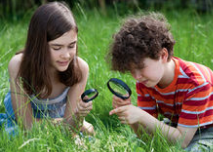Outage Notification
On Thursday, October 30, 2025 at 5am ET we will be updating the NJCTL Moodle site. The site will be unavailable for approximately 4 hours.

As the weather gets nicer and the school year starts to drag, teachers and kids naturally want to be outdoors! Recess isn’t the only opportunity to get outside, there are many topics that can be learned even better “al fresco”. It’s a great opportunity for teaching observation skills, descriptive writing, classification, horticulture, and even physics—stomp rockets need wide open spaces!
Here are some tips for creating, or improving, your outdoor classroom:
1. Be sure that your outdoor classroom has a gathering space; nothing throws off work time more than students treating your class like recess. By starting your class period in a designated space, and gathering all students together to share the lesson’s objectives and expectations of the work that students will complete in the given time, you will help your students internalize that while you are outdoors—it’s still class time.
2. Designate a clear boundary for the outdoor classroom. While a fence or other permanent border is great if you have funding, this can also include the use of geographic indicators. I.e,. go no further than this tree or do not pass the swing-set.
3. Personalize your space. Kids love to see their style reflected in indoor classroom space and the same is true for outdoor space. Working with the school’s art teacher is a great way to personalize the space. Kids can create stepping stones, small murals, etc.
4. Work with school community members to improve the look of your outdoor space with plants. This is the time of year that many gardeners will begin to work in the yard, oftentimes dividing perennials that have grown too large for their current space. Divided plants are a great no-cost way to add plant life to your outdoor classroom. You and your students can learn about native plant species to minimize maintenance and watering.
5. Add inexpensive measurement tools like rain gauges, windsocks, thermometers, meter sticks/measuring tapes, etc. This will help students focus and quantify their observations.